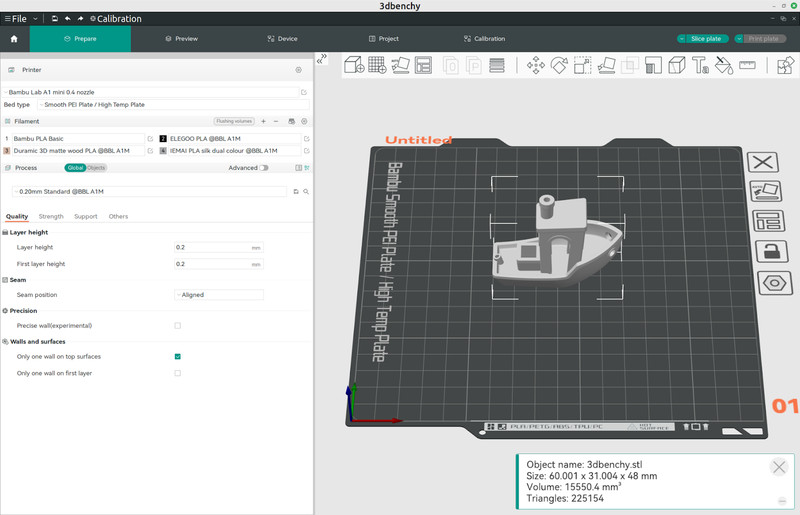Orcaslicer - Overview
Slicer Summary
| Download Link | Https://github.com/SoftFever/OrcaSlicer |
| Compatibility | Windows, Mac, Ubuntu Linux |
| Open Source | Yes |
| Based on | Bambu Studio |
| Owning brand | - |
History
OrcaSlicer’s first release on July 16, 2022 was called “BambuStudio V1.0.10 - SoftFever” and was based on Bambu Studio 01.00.10.05 pre release. SoftFever is the lead developer of OrcaSlicer and the first release was a fork of Bambu Studio, which is open source. Note that this is a day earlier than the first stable release of Bambu Studio itself, so it’s just a little older than Bambu Studio. It was called BambuStudio SoftFever until it was renamed OrcaSlicer on March 17, 2023 with version 1.5.0.
Ease of Use
OrcaSlicer is closely based on Bambu Studio so it’s essentially the same in terms of ease of use for beginners, intermediate users and advanced users. But the calibration menu - see the features section - makes things easier for intermediate and advanced users. They don’t need to go elsewhere to conduct these important tests, it’s built right into the software.
Features
Since OrcaSlicer is very close to Bambu Studio, all of Bambu Studio’s features are present, but there are a few extra advanced features. OrcaSlicer adds a very comprehensive calibration menu, adding temperature towers, flow rate tests, pressure advance tests, retraction tests, tolerance tests, a maximum flowrate test, and a VFA (vertical fine artifacts) test. There is also a built-in link to a tutorial which explains all these tests.
One new feature that’s unique to OrcaSlicer is the “make overhangs printable” setting. This modifies the geometry of the model to make overhangs print without supports, based on a specified maximum angle. A covered hole with a set surface area can also be printed without supports.
OrcaSlicer can also apply “mouse ear” brims on sharp angles which might curl without a brim. These are small circles, not full brims, and are only needed at thin, sharp tips of objects. OrcaSlicer will automatically apply these if this type of brim is selected.
OrcaSlicer removes the “share” button which published models on Bambu Lab’s MakerWorld. These could be added manually but the .3mf files OrcaSlicer saves are not compatible with the .3mf files saved by Bambu Studio that MakerWorld expects.
Since OrcaSlicer is intended to be more universal and not limited to Bambu Lab printers, it adds network control for printers by IP address through PrusaLink, PrusaConnect, OctoPrint or Klipper, Duet, FlashAir, AstroBox, Repetier or MKS. This is accessed through the “device” tab. This allows integrated control of a networked printer directly in the slicer.
New, unique features coming for version 2.0.0 include scarf seams which can hide seams in circular objects by overlapping them and small area flow compensation which reduces over-extrusion at the edges of solid infill.
Compatibility
OrcaSlicer does not limit itself to Bambu Lab printers, so it supports not only all Bambu Lab printers and all the other printers Bambu Studio does but also adds a wide variety of printers from dozens of manufacturers. There is much wider compatibility than Bambu Studio.
Community Support
OrcaSlicer is developed by the community - unlike other slicers, there is no corporate sponsor, so it has attracted a lot of developers wanting to incorporate new ideas. It is new but rapidly gaining popularity. Most of the help and development occurs in their GitHub discussion, which unfortunately doesn’t list the number of members or discussions but the project has been “starred” 4,500 times. There’s an official Discord server with 12,500 users. There are 3 unofficial Facebook groups with 11,800 members, 2,700 members and 551 members. The OrcaSlicer subreddit has 1,400 members.
Screenshot
